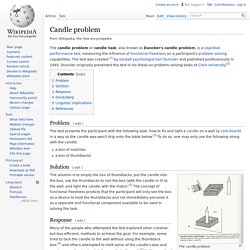

Happiness is wanting the problems you have and wanting to solve them. » Mark Manson.
« Good problem-solving is a product of both critical and creative thinking. The best way to combine them is to have some process in place that allows each to shine through. » Zat Rana
« A problem solving strategy : if you’re stuck, shift up a level or two (think bigger picture) or down a level or two (think finer details). Many problems are solvable at a different level. This works for strategy too.
Reframing the problem. Problem solving. Problem solving consists of using generic or ad hoc methods, in an orderly manner, for finding solutions to problems. Some of the problem-solving techniques developed and used in artificial intelligence, computer science, engineering, mathematics, medicine, etc. are related to mental problem-solving techniques studied in psychology.
Definition[edit] The term problem-solving is used in many disciplines, sometimes with different perspectives, and often with different terminologies. For instance, it is a mental process in psychology and a computerized process in computer science. Problems can also be classified into two different types (ill-defined and well-defined) from which appropriate solutions are to be made. Psychology[edit] While problem solving accompanies the very beginning of human evolution and especially the history of mathematics,[4] the nature of human problem solving processes and methods has been studied by psychologists over the past hundred years. Creative problem-solving. Creative problem-solving is the mental process of searching for an original and previously unknown solution to a problem.

To qualify, the solution must be novel and reached independently.[1] Creative solution types[edit] The process of creative problem-solving usually begins with defining the problem. This may lead to finding a simple non-creative solution, a textbook solution, or discovering prior solutions developed by other individuals. If the discovered solution is sufficient, the process may then be abandoned[2][3]. If a creative solution has broad application – that is, uses that go beyond the original intent –, it may be referred to as an innovative solution, or an innovation (some innovations may also be considered an invention). "All innovations [begin] as creative solutions, but not all creative solutions become innovations Techniques and tools[edit] Claude Shannon: How a Real Genius Solves Problems. It took Claude Shannon about a decade to fully formulate his seminal theory of information.

He first flirted with the idea of establishing a common foundation for the many information technologies of his day (like the telephone, the radio, and the television) in graduate school. It wasn’t until 1948, however, that he published A Mathematical Theory of Communication. This wasn’t his only big contribution, though. As a student at MIT, at the humble age of 21, he published a thesis that many consider possibly the most important master’s thesis of the century. To the average person, this may not mean much. The word genius is thrown around casually, but there are very few people who actually deserve the moniker like Claude Shannon.
One of the subtle causes behind what manifested as such genius, however, was the way he attacked problems. Got a wicked problem? First, tell me how you make toast [ TED Talk : Tom Wujec ] Candle problem. Problem[edit] The test presents the participant with the following task: how to fix and light a candle on a wall (a cork board) in a way so the candle wax won't drip onto the table below.[3] To do so, one may only use the following along with the candle: a box of matchesa box of thumbtacks.

Hardship. Strategies. Adaptation. Priority.
Learning Zone. Invention. Draw How To Make Toast - a Wicked Problem Solving™ Tool. Motivational Interview. Critical Thinking. Conflict Management.